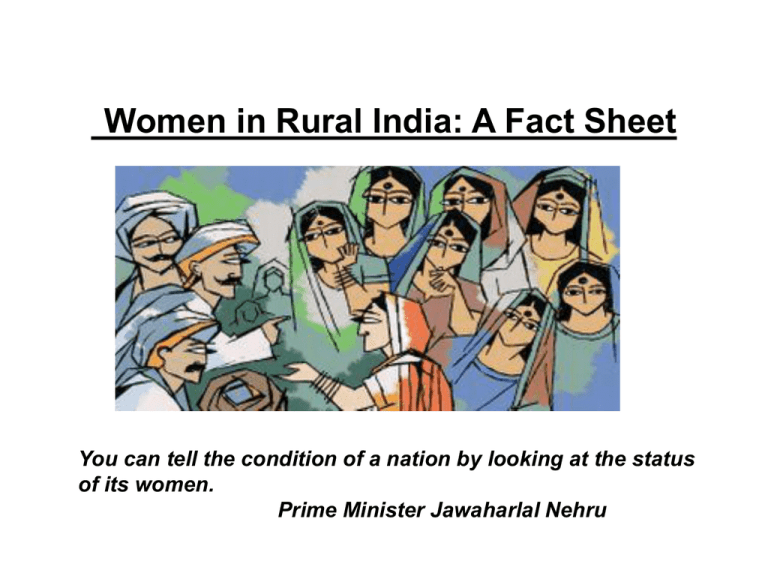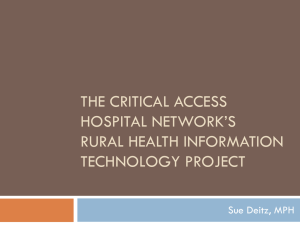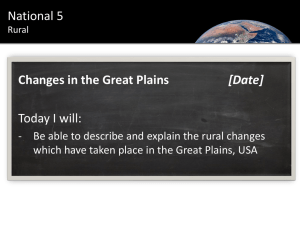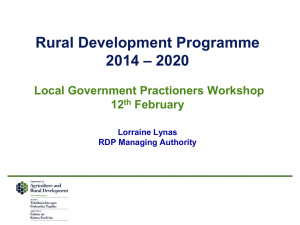
Women in Rural India: A Fact Sheet
You can tell the condition of a nation by looking at the status
of its women.
Prime Minister Jawaharlal Nehru
History of Indian women
In ancient India, women occupied important
position in the society.
Vedic Ages
Women were at par with the men.
Medieval Ages
The condition of women deteriorated during
this period because of Islamic influence.
Modern Era
Still the condition of women in Indian society
specially in rural India is not good.
Women in India: a quick look
• Total Population : 1027.02 mn
• Male
: 531.28 mn
• Female
: 495.74 mn
• Total Rural Pop
• Male
• Female
: 718.87 mn
: 370.76 mn
: 348.11 mn
Sex Ratio
: 933
Rural Women & Employment
Female worker comprises of 11.98% of the working
population of the country
Distribution of Workers by sectors (Figures %) in 2001
Total
Primary Secondary Tertiary
60.42
17.49
22.09
Rural
76.24
11.82
11.95
Urban
8.69
33.95
57.36
Source: NSSO,2001
Rural Women & Employment
Women workers in Rural India-1999-2000
Sector Description No of women
workers (%)
Primary Sectors
85.3
Mining and
quarrying
Manufacturing
0.3
Construction
1.1
Others
5.7
7.6
Rural Women in Farm Sector
one third of the agriculture labour force and
nearly half of self employed farmers are
women
In overall farm production, women’s
average contribution: 55-66% of total
labour.
In animal husbandry : 20 million women as
compared to 1.5 million men
Due to migration of male members of the
family to off farm employment, one-third of
the rural family for all purpose is headed by
women. This can be seen as
“feminization of agriculture”
Health and Nutritional Status
Sex Ratio in Rural India
0-4 years age grp. :975 per 1000 males
5-9 years age grp. :940 per 1000 males
10-14 years age grp.:816 per 1000 males
Reason for this disorder :-
• social discrimination
• neglect of female in the matter of health
12 mn female children born every year……
about 1.5 million of them die before celebrating
their first birthday
one million before their fifth year
9 million will be alive at the age of 15
Health and Nutritional Status
Maternal Mortality
Maternal death is the death of the woman
while pregnant of within 42 days of
termination of pregnancy, irrespective of
the duration and site of pregnancy, from
any cause related to or aggravated by the
pregnancy or its management but not from
accidental or incidental cause.
More maternal deaths occur in our country
in one week than in all of Europe in one
year.
Maternal Mortality
MMR among scheduled tribes
: 652
MMR among scheduled castes
: 584
MMR among women of other castes : 516
MMR among illiterate women
: 574
MMR among women who completed middle school :484
MMR in Less-developed villages
: 646
MMR in moderately developed villages: 501.
MMR in well-developed villages
Source : Unicef, India
: 488
Rural Women and Education
Disparities of literacy rate among men & women
Urban Male
Urban Female
86.42%
79.46%
Rural Male
Rural Female
71.18%
46.58%
Scheduled Caste Male
Scheduled Caste Female
49.91%
23.76%
Scheduled Tribe Male
Scheduled Tribe Female
40.65%
18.19%
Source: http://education.nic.in/ (HRD Ministry )
Rural Women and Education
Female Literacy in India( %) : 1961-2001
Year
Rural
Urban
Overall
1961
10.13
40.46
15.33
1971
15.52
48.84
21.97
1981
20.66
54.40
28.29
1991
30.62
64.05
44.69
2001
46.58
79.46
59.21
Source: http://education.nic.in/ (HRD Ministry)
Rural Women and PRI
(Panchayati Raj Institution)
The 73rd and 74th Constitutional
Amendment Acts, which guarantee that all
local elected bodies reserve one-third of
their seats for women
Local women–the vast majority of the
villages are illiterate and poor–have come
to occupy as much as 43% of the seats in
panchayats.
The percentages of women in various
levels of political activity have risen from
4-5% to 25-40% .
Government Interventions for
development of rural women
Government Programmes : Development of Women and Children
in Rural Areas (DWCRA)
Supply of Improved Toolkits to Rural
Artisans (SITRA)
Swarnajayanti Gram Swarozgar
Yojana (SGSY) was launched in April
1999 : This is a holistic programme
covering all aspects of self-employment
such as organization of the poor into
Self-Help Groups (SHG’s), Training ,
Credit, Technology, Infrastructure and
Marketing.
Family Welfare Programme
National
Nutritional Anemia Control
Programme
TT immunization of pregnant mother
During the Eighth Plan maternal health
programmes were integrated with other
rogrammes and became part of the Child
Survival and Safe Motherhood (CSSM)
Programme
During the Ninth Plan all interventions
under the CSSM Programme have become
part of the Reproductive and Child Health
(RCH) Programme.
Future of Rural women
A shift from development to empowerment.
Women empowerment means, “The idea that
giving women power over their economic,
social and reproductive choices will raise
their status promote development and reduce
population growth”.
Future of Rural women
Steps to be taken:
Direct involvement of women in
programming and management.
Effective collaboration with community
organizations.
Organizing and strengthening of women
SHGs.
Sensitization and advocacy of equi-gender
society.
Identifying women’s needs and priorities
while generating employment.
Organizing women into different groups to
undertake certain productive activities to earn
their livelihood and develop rural community.
Some successful Initiatives
• Narsapur Lace Park (Alankriti)
• Lijjat Papad
• Grameen Bank
Narsapur Lace Park
Location: West Godavari District of Andhra
Pradesh . Various villages like
Sitarampiuram, Palkol, Venkatrayapalem,
Antarvedi, Royapeta, Mogaltur
Famous for: Lace work, Crochet Lace
Brainchild of Sanjay Jaju
Objective:to help the cluster in the field of
marketing and network the forward linkages.
Contd…
•
•
•
•
•
First of its kind in India in
providing highest state of art
of services to the rural artisans
Excellent Research &
Development wing with
dedicated crafts persons of
National fame.
Established for the Economic
Development of Rural Women
to achieve their empowerment.
2,00,0000 women are involved
in the craft.
Rs.200 to 300 Millions
currently being exported,
domestic market consumes
any thing between Rs.80 to
Rs.100 Millions.
•Shri Mahila Griha Udyog
Lijjat Papad
selfemployment
opportunities to women at
all its 61 branches.
•15th march 1959,
women inhabitants of an
old residential building in
Girgaum started working
on what they were best
at: making papads!
• Gandhian business strategy, late Chhaganlal Karamshi Parekh and
Damodar Dattani.
• Started of with a paltry sum of Rs.80 and has achieved sales of over
Rs.300 crores with exports itself exceeding Rs. 10 crores.
• Membership has also expanded from an initial number of 7 sisters
from one building to over 40,000 sisters throughout India.
•
Vision: An exclusive women’s
organisation run and managed
by them,a quality product that
these women had the expertise to
make and a work environment
which is not competition-driven
and mechanised.
•
Expansion of Lijjat into a multiproduct company
:Polypropylene, Sasa detergent
& cake and printing divisions.
•
Sisters earn Rs 2,000 to Rs 3,000
every month for six hours of work
everyday from home.
•
Against adoption of modern
technology for mass production or
use machines for packaging.
• Born on the insistence by women oriented studies that
highlighted the discrimination and struggle of women in having
access to credit
• Availability of timely and adequate credit is essential for them
to undertake any economic activity rather than credit subsidy.
• Various case studies show that there is a positive correlation
between credit availability and women's empowerment.
SEWA Movement
• Founder: Ela Bhatt
• Founded in 1971 at
Ahmedabad and registered in
1972 as a trade union
movement for women.
• Established the SEWA bank as
a co-operative to empower
poor self-employed women by
providing them with access to
credit and financial services
and to reduce their
dependence on exploitative
money-lenders.
• Membership is open only to poor women on payment of Rs. 10 (32
cents)as share capital.
• Help women become financially independent and start their own
economic activity
• Cut red-tape/procedures to help illiterate women get small loans
without difficulty








